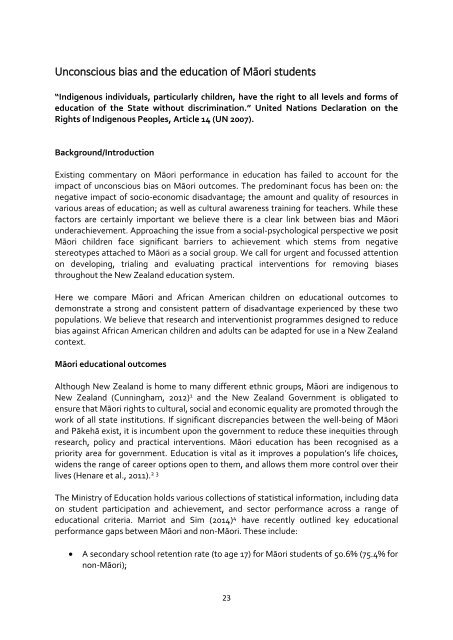UNCONSCIOUS BIAS AND EDUCATION
unconsious-bias-and-education
unconsious-bias-and-education
Create successful ePaper yourself
Turn your PDF publications into a flip-book with our unique Google optimized e-Paper software.
Unconscious bias and the education of Māori students<br />
“Indigenous individuals, particularly children, have the right to all levels and forms of<br />
education of the State without discrimination.” United Nations Declaration on the<br />
Rights of Indigenous Peoples, Article 14 (UN 2007).<br />
Background/Introduction<br />
Existing commentary on Māori performance in education has failed to account for the<br />
impact of unconscious bias on Māori outcomes. The predominant focus has been on: the<br />
negative impact of socio-economic disadvantage; the amount and quality of resources in<br />
various areas of education; as well as cultural awareness training for teachers. While these<br />
factors are certainly important we believe there is a clear link between bias and Māori<br />
underachievement. Approaching the issue from a social-psychological perspective we posit<br />
Māori children face significant barriers to achievement which stems from negative<br />
stereotypes attached to Māori as a social group. We call for urgent and focussed attention<br />
on developing, trialing and evaluating practical interventions for removing biases<br />
throughout the New Zealand education system.<br />
Here we compare Māori and African American children on educational outcomes to<br />
demonstrate a strong and consistent pattern of disadvantage experienced by these two<br />
populations. We believe that research and interventionist programmes designed to reduce<br />
bias against African American children and adults can be adapted for use in a New Zealand<br />
context.<br />
Māori educational outcomes<br />
Although New Zealand is home to many different ethnic groups, Māori are indigenous to<br />
New Zealand (Cunningham, 2012) 1 and the New Zealand Government is obligated to<br />
ensure that Māori rights to cultural, social and economic equality are promoted through the<br />
work of all state institutions. If significant discrepancies between the well-being of Māori<br />
and Pākehā exist, it is incumbent upon the government to reduce these inequities through<br />
research, policy and practical interventions. Māori education has been recognised as a<br />
priority area for government. Education is vital as it improves a population’s life choices,<br />
widens the range of career options open to them, and allows them more control over their<br />
lives (Henare et al., 2011). 2 3<br />
The Ministry of Education holds various collections of statistical information, including data<br />
on student participation and achievement, and sector performance across a range of<br />
educational criteria. Marriot and Sim (2014) 4 have recently outlined key educational<br />
performance gaps between Māori and non-Māori. These include:<br />
<br />
A secondary school retention rate (to age 17) for Māori students of 50.6% (75.4% for<br />
non-Māori);<br />
23


